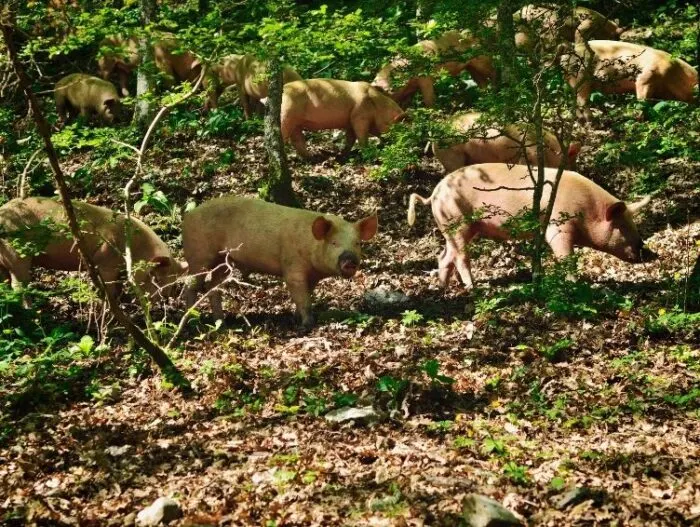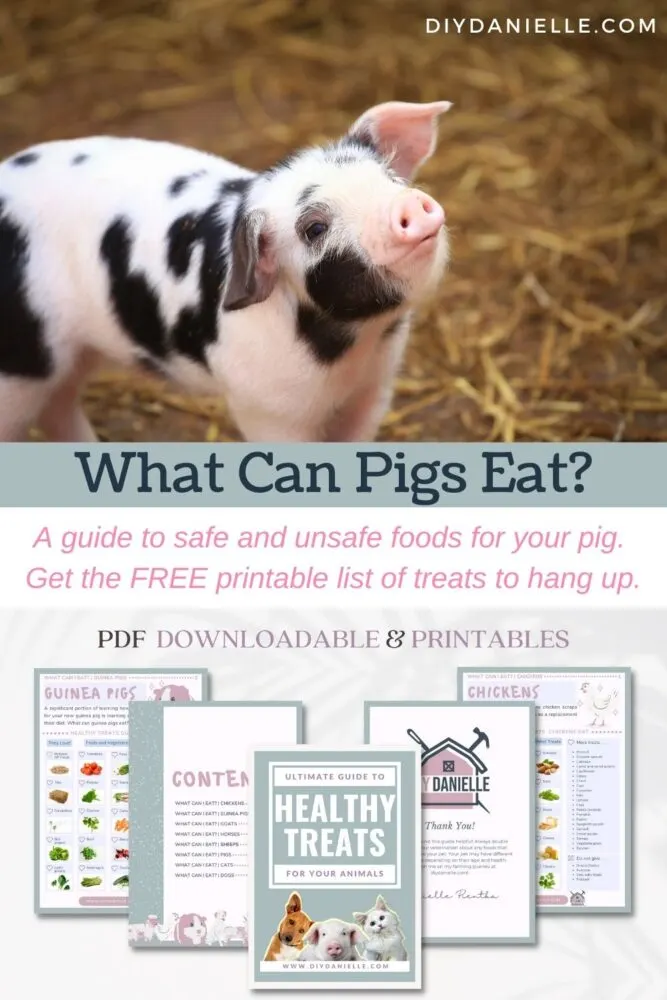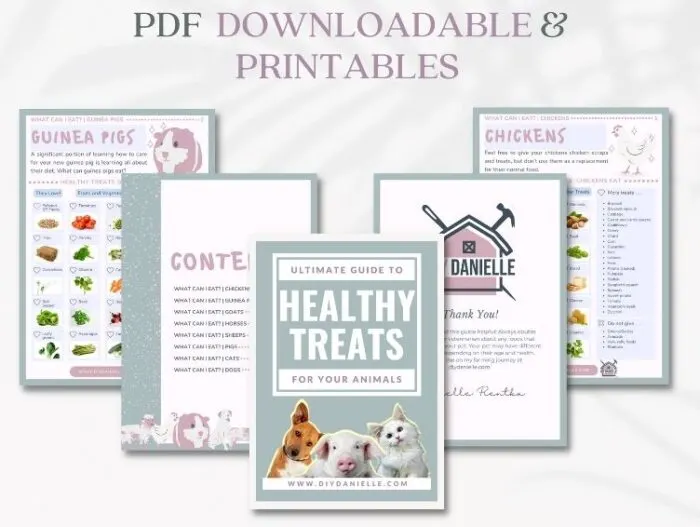What Can Pigs Eat? A guide to feeding your pig, whether you’re raising them as a pet, a breeding pig, or as a feeder pig.
Despite what popular media has taught us over the years, a pig’s diet consists of much more than trash. Pigs have been preferred livestock since ancient times, and yet the general public knows so little about their actual diet.
It can be confusing for the first-time hog farmer to tell the difference between fact and fiction when it comes to keeping pigs well-nourished, so here’s the low-down on what you can feed your pigs.
This post may contain affiliate links which may earn me commissions should you click through them and take certain actions. As an affiliate for Amazon, Cricut, xTool, Home Depot, and other sites, I earn from qualifying purchases. Please DIY carefully. View my full legal disclosures here.
Please read the whole post so you don’t miss any important information!
What you feed your pigs will depend on their purpose: If they’re mini pigs being kept as pets, you may want to speak with your vet about proper nutrition as the small size usually involves calorie restriction. Feed them “like pigs” and you’ll end up with a much larger pig than you anticipated or planned for.
A pig who is pregnant or nursing will have different dietary needs as well. And pigs being raised for meat are usually encouraged to gain weight quickly for earlier processing times. It generally depends on the pig breed, however, as some conservancy/heritage pig breeds take longer to grow out. The trade off is usually better tasting meat (or so I’ve been told).
What Can Pigs Eat?
Commercial pellet feed
It doesn’t get simpler than this! Commercial pig feed is the best thing to feed a growing pig, whether it’s a pet or a pork chop in the making. Pelleted feed consists of a balanced formula, created to meet all the nutritional needs of swine. It also makes things easier on you: it takes the guesswork out of tracking macronutrients like protein and carbohydrates, so you can get a reliable estimate of exactly what your little pigs are eating without having to follow them around with a calculator all day.
Pelleted feed is recommended as a primary feed for piglets and for finishing hogs, but mature swine can be fed a mixture of rationed pellets, grains, and forage, or weaned off of pellets all together until they’re ready for finishing.
Only feed your pig commercially produced feed that’s made specifically for them, not another animal like a dog, a cow, a horse, etc. These animals vary widely in dietary needs, and food that’s made for one will not only be insufficient to sustain another, it could be harmful to their health.
Grains
Adult hogs can subsist almost entirely (almost being an important word here) on whole grains like cracked corn, rolled oats, processed wheat, and barley. It’s important that the grain is processed in some way to make it easier to digest and convert into usable energy. Grains will mostly provide carbohydrates, so make sure your pigs are getting the full range of necessary nutrients by adding other feed sources from this list.
Spent distillers grains, also sometimes referred to as mash, can be fed to adult hogs as long as they’re not pregnant or nursing. Partner up with your local distillery for a low-cost no-waste feed supplement.
Forage
Forage can help fill in the nutritional gaps that the carb-heavy grains leave open. Alfalfa, for example, is a type of sprouted legume that’s high in protein and will help your pig put on lean muscle, which is beneficial no matter what purpose you have in mind for Porky.
Hogs on the pasture will often root around and find their own means of eating. You may have heard that pigs love acorns and other tree nuts, and this is absolutely true, but make sure they only have access to fully ripe acorns and oak leaves, as they can be toxic in their unripe stage.

They may also encounter a stray field mouse or garden snake and do what omnivores do, which is eat (chickens eat mice and small snakes too!). Be sure to continuously monitor for signs of parasites when pasturing hogs.
Many people use pigs to clear land. It’s one way to clear an area overgrown with brush fairly quickly. Their snouts and hooves make quick work of the ground, uprooting small trees and brush such as overgrown blackberry or raspberries.

Giving pigs plenty of room for forage for their food reduces how much feed you’ll need to give them in order for them to reach their optimal weight for butchering, if that’s your purpose for them. You’ll want STRONG electric fencing if you plan to keep pigs on pasture; pigs are smart and will test fencing. They can hear when it’s off and cause quite a bit of trouble if they escape. Electric netting allows you to easily move the fencing around as they clear areas.
When you initially get pigs and train them to the electric, you want to have electric netting with normal fencing around it. This teaches them that they can’t just run through the electric shock.
While current farming practices generally use open pasture for farm animals, more people are moving towards using Silvopasture, or wooded areas, as pasture for livestock. It gives them shade, plenty of forage area, and is healthier for the earth than pulling up entire forests for grazing. Keeping trees helps reduce erosion as well, something that has often caused problems for farmers, particularly in the Dust Bowl area during the Great Depression.
The downside to Silvopasture is the potential safety risk, including plants that might be unsafe. You can read more about this practice in the book Silvopasture: A Guide to Managing Grazing Animals, Forage Crops, and Trees in a Temperate Farm Ecosystem.
Farm goods
Waste not, want not. Pigs can help rid you of excess farm goods like cheese, milk, and eggs from time to time. Don’t include it as part of their regular diet, but sometimes those extra calories lying about can be put to good use, adding protein or essential fats to a pig’s meal. Be sure the goods are still fresh and not expired, as contaminated goods can make your pig sick.
Meat is another subject entirely, and this one can be tricky. Opinions vary widely on whether or not it’s okay to feed your pig meat from other animals, purely from a safety standpoint. Before you decide to give it a go, first check local ordinances to make sure it’s allowed in your area, as it’s become illegal in many places because of disease concerns.
Produce
Pigs love fruits and vegetables of all kinds, and it’s important to provide them with a wide variety of fresh produce to give them a full spectrum of vitamins, minerals and antioxidants. As with other animals, you should also remove seeds and pits from fruits prior to feeding, and offer fruit more sparingly than vegetables due to higher sugar content. Table scraps like vegetable peels, strawberry tops, misshapen produce and uneaten veggies from picky children’s plates are fair game as well!
Try giving them a few of these and listen to them squeal with delight as they munch away:
- Broccoli
- Beets
- Apples
- Squash
- Peas
- Cucumber
- Carrots
- Grapes
- Bell Peppers
- Lettuce
- Cooked beans (not raw or canned)
- Bananas
- Strawberries
- Melons
- Pears
- Pineapple
- And lots of others!
There are few things produce-wise to avoid feeding to your pigs. Raw potatoes or potatoes that have become solanaceous can make your pigs sick and rotting food and vegetables will likewise cause digestive upset. Steer clear of the following:
- Avocados
- Rhubarb leaves
- Unripe tomatoes
- Raw sweet potatoes
- Parsnips
- Celery root
- Brassica roots and seeds
This list is not exhaustive and does not include all possible toxic products your pig could consume, so check with your veterinarian before introducing any new foods to your pig’s diet.
Refined & processed foods
When it comes to refined and processed foods, just because they can eat them, doesn’t mean they should. Just like with humans, processed foods that contain excess sodium, sugars, and fats can cause long-term health issues. A good rule of thumb for pigs (and really any animal in your care) is this: if it doesn’t exist in their natural diet, they probably weren’t meant to live on it. If you do decide to toss your swine a honey bun or a piece of bread every now and then, it’s not the end of the world. Just make sure you limit intake severely to keep your pigs healthy.
Contrary to popular belief, pigs shouldn’t eat trash. They may find their way into it from time to time, but it will be a detriment to their health should they eat something not meant for their consumption. Make sure that your herd doesn’t have access to garbage bins on your property and keep them in an area where they can be supervised.
Now that you have the gist of what to feed your pig, it’s time to apply your knowledge! Get more hot tips on homesteading and raising livestock here.
I have a printable bundle of foods for different farm animals and household pets. Subscribers can get the printable FREE by signing up below!
Please share and pin this post! If you make this project, share it in our Stuff Mama Makes Facebook Group. We have regular giveaways for gift cards to craft stores. You can also tag me on Instagram @doityourselfdanielle; I love seeing everything you make!

Google Web Story: Pet Organization Ideas

